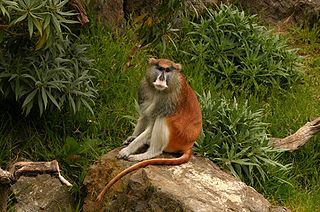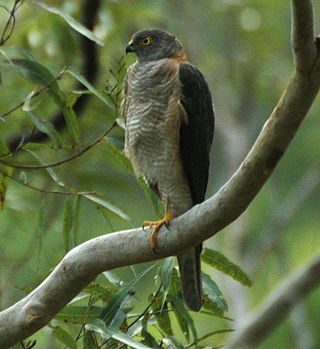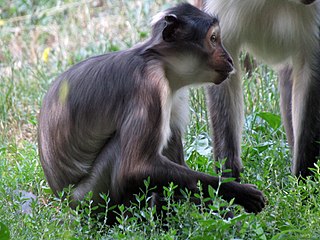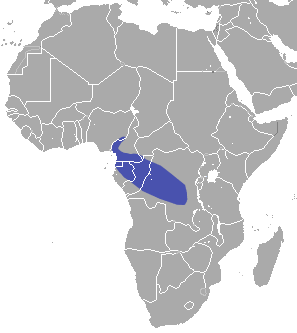
The International Union for Conservation of Nature (IUCN) Red List of Threatened Species, also known as the IUCN Red List or Red Data Book, founded in 1964, is an inventory of the global conservation status and extinction risk of biological species. A series of Regional Red Lists, which assess the risk of extinction to species within a political management unit, are also produced by countries and organizations.

Erythrocebus is a genus of Old World monkey. All three species in this genus are found in Africa, and are known as patas monkeys. While previously considered a monotypic genus containing just E. patas, a 2017 review argued that, based on morphological evidence and heavy geographic separation between taxa, E. patas should be split back into distinct species as recognised in the 19th century.

Accipiter is a genus of birds of prey in the family Accipitridae. With 49 recognized species it is the most diverse genus in its family. Most species are called goshawks or sparrowhawks, although almost all New World species are simply known as hawks. They can be anatomically distinguished from their relatives by the lack of a procoracoid foramen. Two small and aberrant species usually placed here do possess a large procoracoid foramen and are also distinct as regards DNA sequence. They may warrant separation in the old genus Hieraspiza.

The conservation status of a group of organisms indicates whether the group still exists and how likely the group is to become extinct in the near future. Many factors are taken into account when assessing conservation status: not simply the number of individuals remaining, but the overall increase or decrease in the population over time, breeding success rates, and known threats. Various systems of conservation status are in use at international, multi-country, national and local levels, as well as for consumer use such as sustainable seafood advisory lists and certification. The two international systems are by the International Union for Conservation of Nature (IUCN) and The Convention on International Trade in Endangered Species of Wild Fauna and Flora (CITES).

Hugh's hedgehog, also sometimes referred to as the central Chinese hedgehog, is native to central China and Manchuria. It prefers open areas of dry steppe, but can be found in shrubland and forests. It is known to look for food even in daytime on rainy days.

The white-eyelid mangabeys are African Old World monkeys belonging to the genus Cercocebus. They are characterized by their bare upper eyelids, which are lighter than their facial skin colouring, and the uniformly coloured hairs of the fur. The other two genera of mangabeys, Lophocebus and Rungwecebus, were once thought to be very closely related to Cercocebus, so much so that all the species were placed in one genus, but Lophocebus and Rungwecebus species are now understood to be more closely related to the baboons in genus Papio, while the Cercocebus species are more closely related to the mandrill.

A genet is a member of the genus Genetta, which consists of 17 species of small African carnivorans. The common genet is the only genet present in Europe and occurs in the Iberian Peninsula, Italy and France.

A species that is extinct in the wild (EW) is one that has been categorized by the International Union for Conservation of Nature as only consisting of living members kept in captivity or as a naturalized population outside its historic range. Classification requires exhaustive surveys conducted within the species' known habitat with consideration given to seasonality, time of day, and life cycle. Once a species is classified as EW, the only way for it to be downgraded is through reintroduction.
Pristimantis eugeniae is a species of frog in the family Strabomantidae.

The white-headed fruit dove is a species of bird in the pigeon family Columbidae. It was described by the English ornithologist John Gould in 1856, and the specific name eugeniae honours the French empress Eugénie de Montijo. Adults of the species have white heads, a purplish-red breast patch, a grey shoulder patch, olive-green upperparts, greenish underparts with a blue tinge, and a yellowish vent. Juveniles have green heads with the white restricted to the forehead and upper throat, a much smaller grey shoulder patch, and the red breast patch restricted to the centre of the breast.
Hotson's jerboa or the Iranian jerboa, is a species of rodent in the family Dipodidae. It is found in Afghanistan, Iran, and Pakistan.
Blanford's jerboa is a species of rodent in the family Dipodidae. It is native to Central Asia and is found in Turkmenistan, Uzbekistan, Afghanistan, Iran and Pakistan.

The greater forest shrew is a species of mammal in the family Soricidae found in Cameroon, the Central African Republic, the Republic of the Congo, Equatorial Guinea, Gabon, and Nigeria. Its natural habitat is subtropical or tropical moist lowland forest.

The World's 25 Most Endangered Primates is a list of highly endangered primate species selected and published by the International Union for Conservation of Nature (IUCN) Species Survival Commission (SSC) Primate Specialist Group (PSG), the International Primatological Society (IPS), Global Wildlife Conservation (GWC), and Bristol Zoological Society (BZS). The IUCN/SSC PSG worked with Conservation International (CI) to start the list in 2000, but in 2002, during the 19th Congress of the International Primatological Society, primatologists reviewed and debated the list, resulting in the 2002–2004 revision and the endorsement of the IPS. The publication was a joint project between the three conservation organizations until the 2012–2014 list when BZS was added as a publisher. The 2018–2020 list was the first time Conservation International was not among the publishers, replaced instead by GWC. The list has been revised every two years following the biannual Congress of the IPS. Starting with the 2004–2006 report, the title changed to "Primates in Peril: The World's 25 Most Endangered Primates". That same year, the list began to provide information about each species, including their conservation status and the threats they face in the wild. The species text is written in collaboration with experts from the field, with 60 people contributing to the 2006–2008 report and 85 people contributing to the 2008–2010 report. The 2004–2006 and 2006–2008 reports were published in the IUCN/SSC PSG journal Primate Conservation,, since then they have been published as independent publications.

Anabasis is a genus of plants in the subfamily Salsoloideae of the family Amaranthaceae. It is distributed in southern Europe, North Africa, and Asia.











